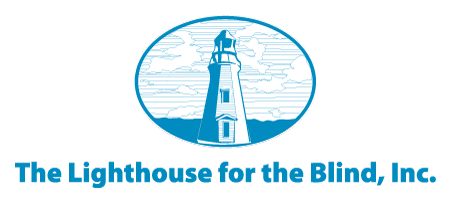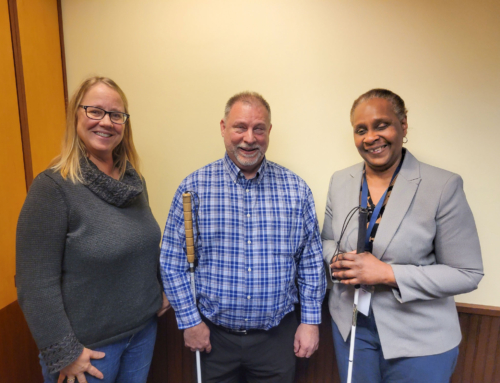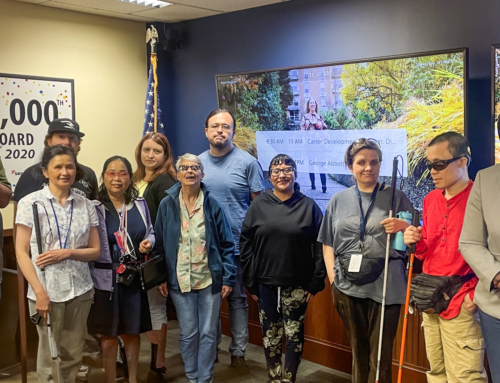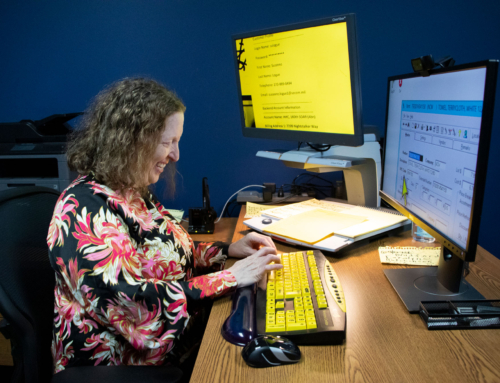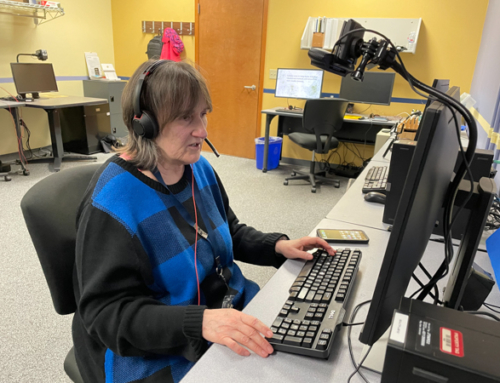The Lighthouse works diligently to improve accessibility for employees as part of our mission to create and enhance opportunities for independence and self-sufficiency for people who are blind, Deaf-Blind, and blind with other disabilities. In pursuit of our goal of becoming a leader in accessibility and assistive technology, the Lighthouse makes it a priority to provide accommodations and training for employees.
In March of last year, our Board of Trustees approved our new Accessibility and Training Policy, reinforcing accessibility as a top priority at all Lighthouse locations. The policy clarifies the Lighthouse’s commitment to promote, facilitate, and encourage innovative accessibility and training initiatives throughout the organization, a commitment crucial to supporting and implementing initiatives which align with our strategic goals and mission. Peggy Martinez, the Lighthouse’s Accessibility Manager, responds to employee’s challenges as they take on a new position or as their vision changes over time. Peggy assesses an individual’s needs and brings the expertise of the organization to find a solution through assistive technology and training. You can read the Lighthouse’s Accessibility Policy in its entirety on the Lighthouse blog at our website, www.seattlelighthouse.org.
Throughout Lighthouse facilities, workstation accessibility solutions include the use of JAWS (Job Access With Speech) screen-reading software, ZoomText screen-magnification software, braille note-takers and embossers, large monitors, CCTVs, talking calculators, hand held magnifiers, and ongoing script writing and technical support to ensure JAWS works properly with other software. At Lighthouse Base Supply Centers, employees use pen labelers that read barcodes, currency identifiers, and floor mats connected to vibrating beepers that alert staff when a customer has approached the counter.
Blind and visually impaired employees working in the Lighthouse Machine Shop use talking calipers to measure parts, and machining equipment is equipped with JAWS and large monitors for visually impaired machinists. Lighthouse facilities are also designed to be accessible to employees, with contrasting wall colors for low-vision employees and American Sign Language interpreters, Tilco raised lines for mobility guides through the building, lighting adjustments in work areas for individual needs, window filters to reduce sunlight glare, and contrasting desktops for low-vision employees.
Through our Orientation and Mobility Program (O&M), instructors assist blind and Deaf-Blind individuals in learning skills to travel safety and independently not only in Lighthouse facilities but within the community. O&M instructors provide instruction on white cane travel, bus and street route planning, safety techniques for low-vision travelers, relocation and route planning for new community members, electronic travel aid training, and supplemental training for guide dog users. O&M instructors meet the needs of numerous employees as they navigate through the ever-changing transit landscape of the greater Seattle area, providing ongoing route planning and safe travel techniques as vision loss and accessibility needs change.
The Lighthouse is continually striving toward our goal of creating opportunities and improving accessibility for employees, through our Employee and Community Services programs and workplace accessibility accommodations. If you haven’t been to visit us in a while, contact Keri Brent at kbrent@seattlelh.org for a tour of our facility and to see our accessibility initiatives in action.
